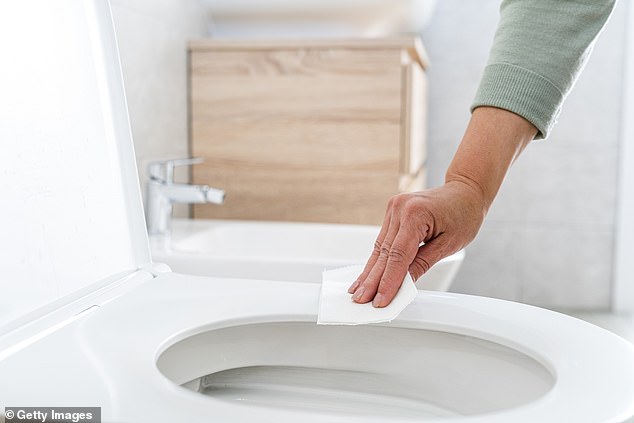The Horrifying Truth About What Happens When You Close the Toilet Lid While Flushing: How to Avoid Getting Sick – and Why You Should NEVER Use a Public Toilet
It is a well-known, but not always well-observed, hygiene advice: close the lid of the toilet seat before flushing, otherwise you run the risk of potentially infectious fecal particles being spread throughout the bathroom in a fine, invisible mist.
A 2022 study from the University of Colorado Boulder, US, seemed to confirm the received wisdom.
Researchers used lasers to illuminate the ‘fog plumes’ that spray from the bowl when it is flushed, and found that they can shoot 1.5 meters high in eight seconds. The atomized toilet water also spread horizontally.
The concern is that if the last person to use the bathroom has a highly contagious disease such as norovirus or hand, foot and mouth disease virus – which is known to spread through feces as well as other forms of transmission – the next user may be unintentionally exposed to bacteria or viruses in the air and other surfaces, especially in public restrooms.
And at this time of year, when many diseases are rampant, caution is more important than ever.
Dr. Primrose Freestone, professor of clinical microbiology, says good handwashing is essential
‘When you flush, traces of whatever you put in the pan will be present in the spray created by the water rinse,’ says Dr Primrose Freestone, associate professor of clinical microbiology at the University of Leicester.
‘Human feces can contain a range of transmissible potential pathogens: Campylobacter, Candida, Cryptosporidium, Enterococci, Escherichia coli, Salmonella, Shigella, Staphylococci, Streptococci And Yersinia bacteria – but also viruses such as norovirus, rotavirus and hepatitis A and E, and Covid-19 to name a few.’
The Colorado study, published in the journal Scientific Reports, did not test how much the spray was reduced if the lid was closed before rinsing.
But new research suggests that even closing it won’t solve all these pathogenic problems.
In the study, published in the American Journal of Infection Control, researchers from the University of Arizona found that while lowering the lid slightly reduced the spray, it did not significantly prevent areas around the toilet from becoming contaminated.
Not surprisingly, the lid and seat were the most contaminated areas in all cases, although some contamination was also evident on the walls and floor.
‘The risk of infection would be reduced (by lowering the lid) because the spray path of the rinse is shortened, but you now have a contaminated lid to clean,’ says Dr Freestone.
‘So wipe the lid with a tissue and then spray it with an anti-infective surface spray or bleach; allow to dry naturally.
‘While you’re working on the lid, it’s a good idea to clean the seat and flush handle. And then wash your hands thoroughly.’
But even if all else fails, this final instruction—washing your hands—is key.
After all, no study has yet shown that these plumes can definitively lead to infection. It is the dose of fecal pathogens – the number of germ cells – that determines whether there is an infection, says Dr. Freestone.
And while “fecal pollution in the environment (also called sewage) is considered a major source of human infection,” it is not known whether enough of one pathogen is emitted from a toilet flush to cause illness.
Instead, infections “usually result from eating contaminated food or the transmission of bacteria through the mouth due to fecal contamination of hands, food, and objects or surfaces,” Dr. Freestone explains.

Clean all bathroom surfaces regularly with disinfectant to avoid contaminating yourself
It is dirty hands that spread contamination on surfaces, and other hands that then pick up those bacteria or viruses and transfer them to our mouth or eyes (when we rub them).
‘Washing hands is therefore very important, but not everyone washes their hands properly after going to the toilet, so anything those unwashed hands touch can become contaminated with faeces,’ warns Dr Freestone.
‘Hands that have just wiped their bottoms can then press the handle of a soap dispenser, or turn on a tap, and (with now clean hands) turn off the same (now soiled) tap.’
So at home, clean all bathroom surfaces regularly with disinfectant and be religious about your own hand hygiene at all times to avoid contaminating yourself.
You can also alleviate any concerns about possible infections from toilet plumes by regularly cleaning towels, bath mats, and washcloths.
As Dr Freestone explains: ‘In an open bathroom, the spray from the toilet can reach the towels – how far that spray goes depends on the water pressure and how close the towels were to the toilet.’
Based on the fact that the Colorado study found that the spray from an open toilet can reach a height of 5 feet and that the spray can travel with a breeze, most small to medium bathrooms should place towels in potential proximity of the plume.
‘To kill the germs on bathroom or towels, the NHS recommends washing with a 60 degree detergent after each day of use,’ adds Dr Freestone.
‘This prevents towels from smelling musty and ensures they are properly disinfected, important if towels are shared or if someone in the home has a transmissible infection.’
And finally: another reason to neatly store your belongings in the bathroom cabinet, instead of leaving toothbrushes, makeup and washcloths on the counter.
‘It’s a good idea to cover your toothbrush as it prevents it from potentially becoming contaminated by flying insects crawling over it and depositing germs, dust settling on it or contamination from random droplets from the toilet flush,’ adds Dr Freestone.
‘The NHS recommends rinsing your toothbrush with hot water after each use and allowing it to air dry in between uses.’
Mom was right to put things away neatly!
